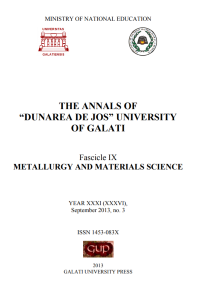A Two-Step Inverse Analysis Approach Used to Identify the Mechanical Properties of Metallic Materials Subjected to Large Plastic Strains. Applications to Local Investigations of Surface Layer’s Behaviour
Abstract
The aim of this research work is to improve the experimental and numerical analysis of the local mechanical properties corresponding to metallic alloys used by bulk forming processes. A non-conventional upsetting test and an optimal direct extrusion device designed by the authors are used in order to identify the constitutive rheological equations and the friction models, starting directly from measured load-stroke curves. A two-step inverse analysis strategy is thus proposed starting from a complete Finite Element Model of the experimental tests and using a strong numerical coupling of the FEM with an optimization platform in charge with the automatic parameters identification. The obtained results are correlated with experimental investigations based on X-Ray, EBSD and hardness measurements concerning the microstructure and the local mechanical properties of the surface layer obtained from a conical extrusion process.
Downloads
References
[2]. S. Diot, D. Guines, A. Gavrus, E. Ragneau - Minimization of Friction Influence on the Evaluation of Rheological Parameters from Compression Test: Application to a Forging Steel Behavior Identification, J. of Eng. Mat. and Tech., 131, n°1 (2009), 10 pages.
[3]. A. Gavrus, H. Francillette, D. Thien Pham - An optimal forward extrusion device proposed for numerical and experimental analysis of materials tribological properties corresponding to bulk forming processes, Tribology International, 47 (2012) pp. 105-121.
[4]. A. Gavrus - Identification automatique des parametres rhéologiques par analyse inverse (Automatic identification of rheological parameters by inverse analysis), PhD Thesis, ENSMP, Paris, France, 1996.
[5]. B. Boyer - Méthode inverse et calcul de sensibilité semianalytique: application à l’identification de paramètres rhéologiques et tribologiques au cours des procédés de mise en forme, PhD thesis, ENSMP, Paris, France, 2001.
[6]. Q. Zhang, M. Arentoft, S. Bruschi, L. Dubar, E. Felder - Measurement of friction in a cold extrusion operation: study by numerical simulation of four friction tests, Proc. of the Esaform Conf. on Metal Forming, P. Boisse et al. (Eds), Lyon, 2008, pp. 57-60.
[7]. D. Thien PHAM - Conception optimale d’un test d’extrusion directe pour l’investigation et l’identification par analyse inverse des propriétés tribologiques des matériaux métalliques utilisés dans le forgeage volumique à froid, PhD Thesis, INSA Rennes, France, 2011.



